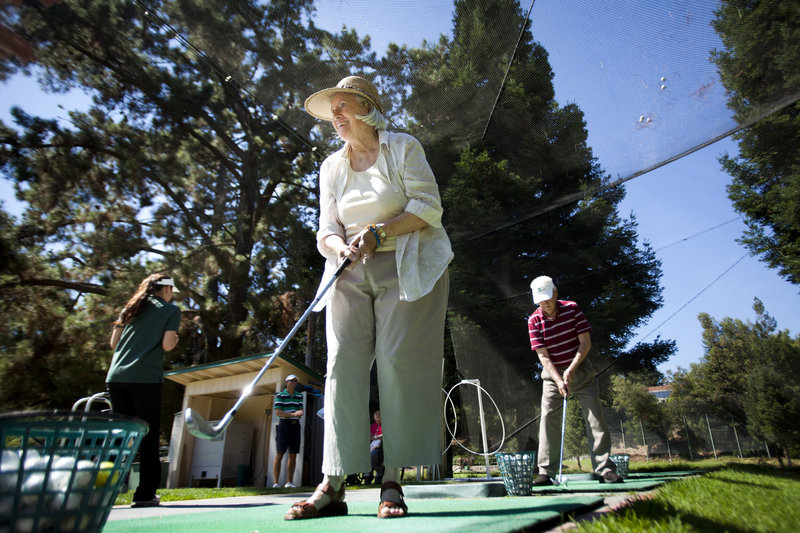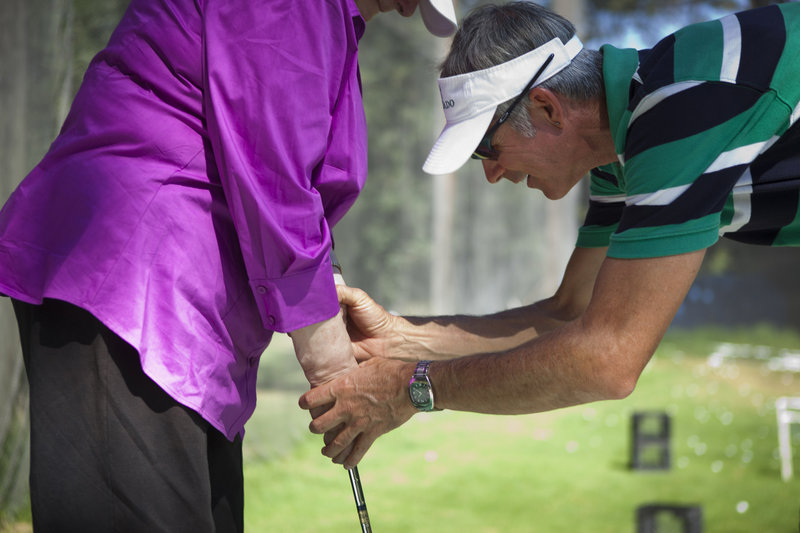SAN JOSE, Calif. – Names, dates, places — such memories are lost to the unforgiving chasm of Alzheimer’s disease.
But when 84-year-old Jim Byerlee stepped up to the driving range at Cupertino, Calif.’s Deep Cliff Golf Course, he swung with the graceful rhythm of a long-ago athlete, sending the ball skyward in an elegant arc.
“You get lucky sometimes,” said the bemused Byerlee, a renowned U.S. Geologic Survey geophysicist with a PhD from the Massachusetts Institute of Technology.
Life with dementia can feel cloudy, confused, sleepless and agitated.
But once a week, a handful of residents of Belmont, Calif.’s Silverado Senior Living briefly defy gravity, and their illness, with a simple game of golf. Facts fade, but a fairway is forever.
“I was trying to hit it short,” explained Matilda McNaughton, 71, who exchanged her walker for a wedge, then hit a perfect pitch shot onto a lush carpet of green.
As America ages and the Alzheimer’s population grows, caregivers and geriatricians are working to rethink the possibilities of life with the disease, a catastrophic deterioration of the mind.
There is no cure. No drugs have been proven to do more than slow the progression of the disease, caused by damage and death to brain cells.
An estimated 5.2 million Americans have Alzheimer’s, a statistic expected to grow according to the Alzheimer’s Association as baby boomers pass through their 60s and 70s.
But experts say that outdoor activities — particularly those that were enjoyed in younger years — can make day-to-day life more pleasant, even enriching.
And muscles remember what the mind cannot.
“The nature of the disease is that it doesn’t march uniformly, from cell to cell,” although eventually it affects every aspect of life, said William H. Fisher, CEO of Alzheimer’s Association of Northern California. “I have known patients who could still play the piano very well. In art therapy programs, some people who are pretty shut down will re-engage,” said Fisher. “My grandmother went to same Presbyterian Church every Sunday, sitting in the same pew, and she knew the drill — when to stand up, when to sit down.”
Research has shown that one of the areas of the brain most immediately affected by Alzheimer’s is the medial/temporal lobe, especially the hippocampus, which consolidates and stores short-term memories.
But other types of memory that appear to rely on different neural systems in the brain remain accessible longer, say scientists. These include procedural memory, such as how to count from one to 10, or motor memory, such as how to ride a bike — or swing a golf club.
There are other benefits, say experts.
“With Alzheimer’s, the big behavioral problems that come along with the diagnosis are agitation, present in 60 percent of patients, and sleep disturbance, which is present in 70 percent of patients,” said Jeffery Newell, research coordinator for the Aging Clinical Research Center in the Department of Psychiatry at Stanford University’s School of Medicine.
“Getting patients outside and doing things like golf, as a general rule, wears them out and exposes them to sunlight, which helps them sleep better at night,” he said. “Our first recommendation to families is to get them outside for physical activity — a walk, gardening, even sewing — to get some sun. It helps keep the peace. If someone is agitated, and throwing the remote control at you, you can’t take care of them.”
The retired executives, engineers and other professionals who can afford to live at Silverado — a $72,000 to $108,000 a year “memory care” facility tucked into a verdant hillside, on a six-acre manicured campus with secure fencing, locked doors and 24 hour nursing — look forward to the Wednesday outings. Five staff accompanied seven golfers.
“They are very accomplished people and we can’t forget that,” said Silverardo administrator Daizel Gasperian. “It gives them a sense of freedom, and dignity. Everything is right. They feel empowered and more energetic. It’s normalcy.” Two hours before tee time, Ralph Dinardi waited patiently, a putter in his hand, “like Bing Crosby and Bob Hope.” When not on the course, the retired Westinghouse mechanical engineer likes to practice his putting in his carpeted bedroom, hitting a whiffle ball into a Hula-hoop.
“I find the game fascinating,” he said, in a written statement he had carefully typed out himself. “I understand the dimples on the balls make them travel almost twice as far.”
Deep Cliff pro Gerry Benton celebrated each shot like it was the 18th hole at Pebble Beach.
“It is deeply satisfying,” said Benton, who as a child grew devoted to his maternal grandmother.
“One rule I made for myself: Take the word ‘remember’ out of my vocabulary,” said Benton.
“I used to go into the ‘golf teaching mode,’ almost reflexively,” he said. “I would say ‘Remember we worked on this? Remember how you put your hands like that?’ But, of course, they don’t.”
“Now we start new, every time. It is very much ‘in the moment.’ It’s not five minutes from now. It’s not building on something we did before. All of my attention is there. I’m not thinking about the future, or past,” he said. “It is really refreshing.”
Byerlee grew annoyed when a plastic tee tipped over. “What do I do with this?” he asked. Nearby, Don Thor, sharply dressed in Dockers and topsiders, just sat quietly and watched.
But in the warm sunshine, in the late afternoon of their lives, no one fretted about scores, sandtraps or hitting par.
“I’m a late bloomer,” giggled Annette Hotz, 87. “I really truly love the game.”
Copy the Story Link
Send questions/comments to the editors.




Success. Please wait for the page to reload. If the page does not reload within 5 seconds, please refresh the page.
Enter your email and password to access comments.
Hi, to comment on stories you must . This profile is in addition to your subscription and website login.
Already have a commenting profile? .
Invalid username/password.
Please check your email to confirm and complete your registration.
Only subscribers are eligible to post comments. Please subscribe or login first for digital access. Here’s why.
Use the form below to reset your password. When you've submitted your account email, we will send an email with a reset code.